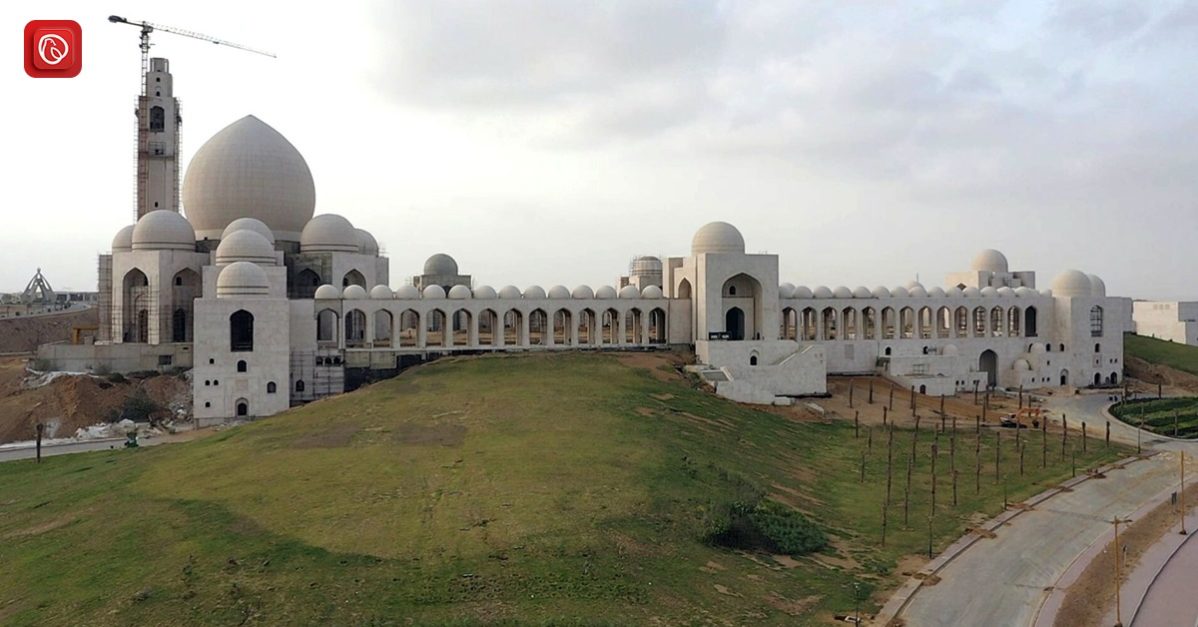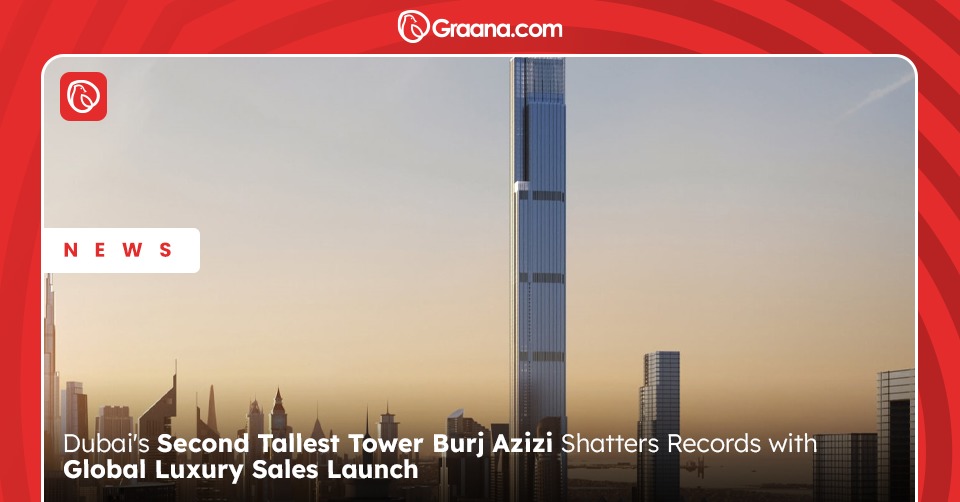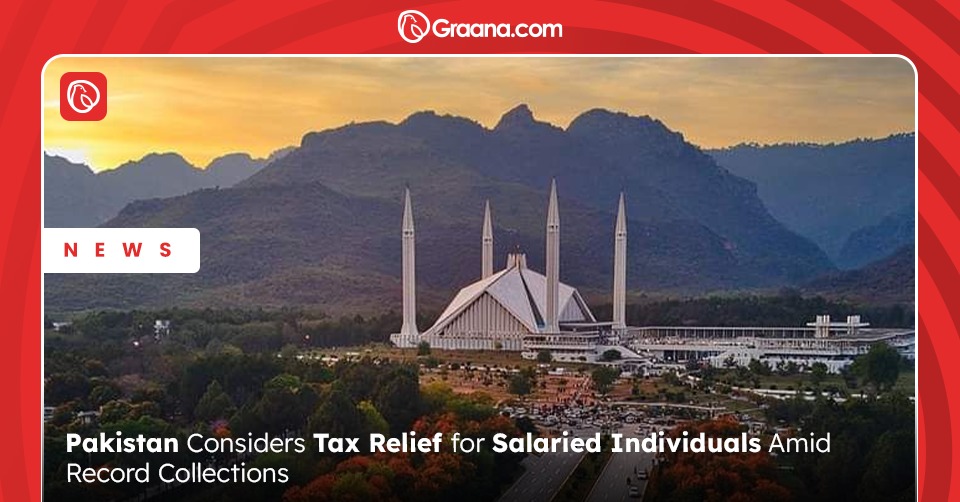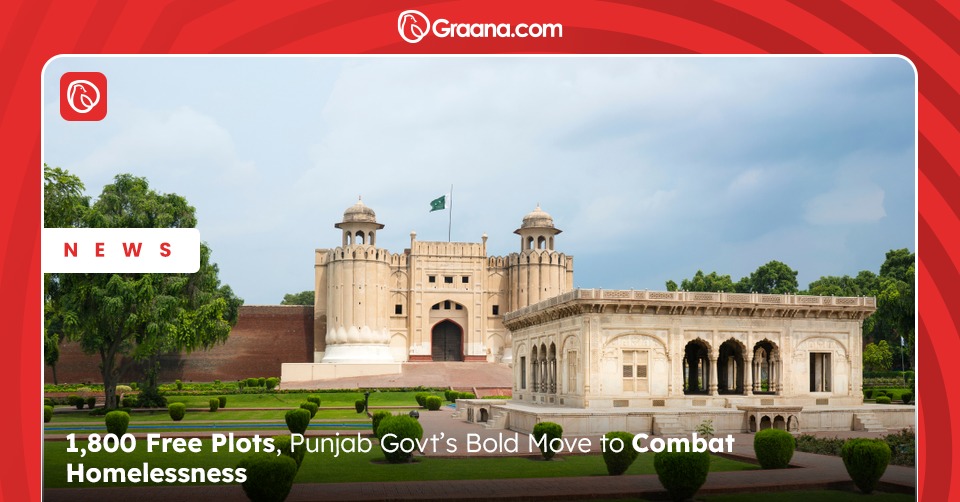Mosques hold a sacred significance for Muslims globally, serving not only as places of worship but also as vibrant hubs for communal activities and centres of Islamic artistry. Acting as the pulsating core of Islamic culture, they accommodate prayers, mark festivities during Ramadan, serve as educational and social welfare institutions, and aid in conflict resolution. The spiritual leader, known as the imam, leads the congregation in prayers.
With their origins dating back to the early days of Islam, the Prophet Muhammad (PBUH) was instrumental in building the first mosque in Medina, underscoring his commitment to establishing a dedicated place of worship for Muslims. The area surrounding the Kaaba Stone in Mecca is often recognised as one of the earliest Muslim centres of worship, revered since the 7th century. Both these cities, located in contemporary Saudi Arabia, hold paramount importance in the Islamic faith.
Among the world’s largest mosques, the “Grand Jamia Masjid Karachi” is a notable example. Ranking as the third largest mosque globally and the largest in Pakistan, it boasts an architectural style that blends Islamic and Mughal influences, drawing inspiration from mosques in Malaysia, Turkey, Iran, Kuwait and UAE.
Graana.com discusses everything you need to know about Grand Jamia Masjid Bahria Town Karachi.
Summary
| Category | Details |
|---|---|
| Location | – Centrally located in Bahria Town Karachi, visible from every corner. |
| Architectural Design | – Designed by Pakistan’s top-notch architect Nayyer Ali Dada.
– Blends Islamic and Mughal architectural styles. |
| Features | – Main Entrance: Grand entrance inspired by Mughal glory.
– Domes and Arches: 128 domes, 488 arches of different sizes. – Minaret: 333 feet tall marble-clad minaret. – Courtyard: Imported Granite floors named ARLASH. – Gardens and Water Bodies. |
| Islamic Community Centre | – Includes an Islamic University, Library, Museum, Women’s Programming Center, and Auditorium. |
| Local Essence | – Built using local materials such as Royal cream boticion marble from Baluchistan, Sindhi materials, and Patterns. |
| Capacity | – Total capacity of 800,000 worshippers.
– Central prayer hall for 40,000 worshippers. – Courtyard for 260,000, open spaces for special gatherings. |
| Interior | – Embellished with Kofic Arabic calligraphy, Kashikari, mosaic work, marble carving, stained glass, wooden traceries, and chandeliers.
– Blends Hala and Sindhi culture patterns. |
| Concept and Design | – Evolved from building a central Jamia Masjid to a monumental Masjid symbolizing unity.
– Blends heritage and futuristic perspective. |
| Indigenous Material | – Various varieties of marble stones used, including royal cream boticino, Verona, jungh shahi gold, bisham green, and more. |
| Location | – Centrally located in Bahria Town Karachi.
– Approachable via the 400 ft wide Jinnah Avenue. |
| Development Status | – Construction began in 2015.
– Final stages of completion with the enormous tower visible from miles away. |
Grand Jamia Masjid Bahria Town Karachi Location
Situated at the epicentre of Bahria Town Karachi, the Grand Jamia Mosque will enjoy a central location concerning all the key developments within Bahria Karachi. This includes Bahria Paradise, Bahria Sports City, Bahria Golf City, and Midway Commercial.
The 400-foot-wide Jinnah Avenue, running adjacent to the Grand Jamia Mosque, ensures convenient accessibility for the entire populace of Bahria Karachi to this remarkable landmark.
Concept and Design
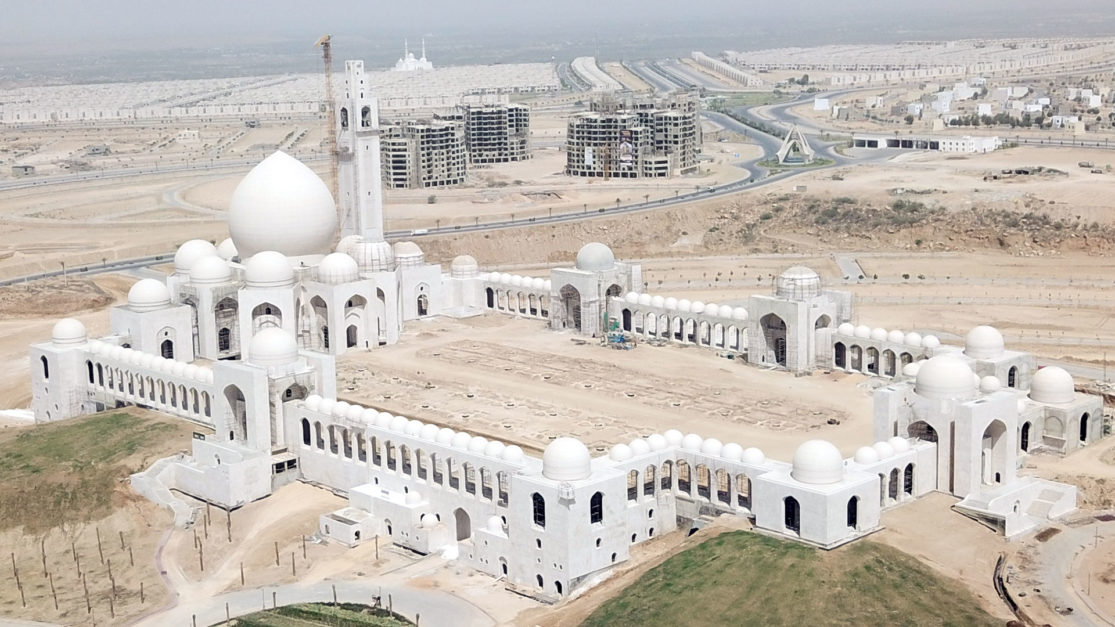
The conception of a central Jamia Masjid in Bahria Town Karachi developed into the idea of constructing a monumental Masjid, signifying unity for Bahria Town, Pakistan, and the wider Ummah. Through collaboration with renowned architects in Pakistan, Bahria Town aims to make a statement that embodies a seamless blend of heritage and a forward-looking vision, portraying a sense of harmony and continuity in its design.
Architecture and Artwork
The Badshahi Masjid in Lahore and the Jama Masjid in Delhi have significantly impacted the architectural style of the Grand Jamia Masjid.
Even more striking is the Grand Jamia Masjid in Bahria Town Karachi, which integrates and draws inspiration from various Islamic architectural styles, including those from Turkey, Malaysia, and Iran. The interior design will reflect influences from Mughal, Sindh, Bukhara, Samarqand, and Bukhara art.
The mosque will feature a towering 325-foot minaret, evoking the grandeur of ancient Islamic mosques, and its prominence will be visible from various points across Bahria Town Karachi.
Nayyar Ali Dada, a renowned Pakistani architect, was the mastermind behind the design of the Grand Jamia Masjid Karachi. He also spearheaded the construction of Lahore’s Bahria Town Grand Jamia Mosque, the largest mosque in Pakistan, capable of accommodating 70,000 individuals overall, with an internal capacity of 25,000.
Internally, the masjid will have embellishments with traditional Islamic calligraphy, mosaic ceramics, tiles, and marble. At the same time, the exterior blocks will be enveloped in pristine white marble featuring intricate geometric design patterns.
Construction and Capacity
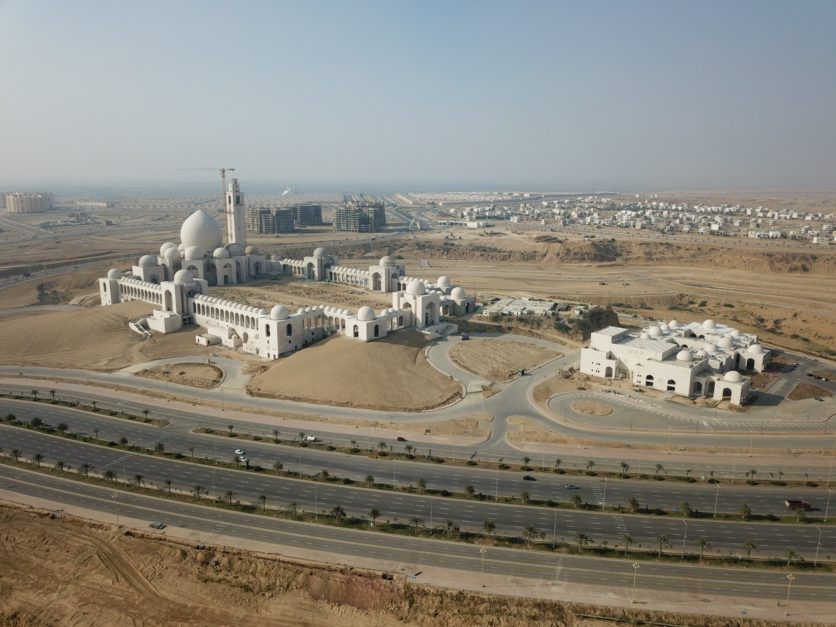
In 2015, Nosherwan, the most senior employee of Bahria Town Karachi, oversaw the commencement of the construction of the Jamia Masjid. The mosque is Pakistan’s largest concrete structure, encompassing a sprawling construction area of 200 acres and 1,600,000 square feet.
Boasting a collective capacity of 50,000 individuals, both inside and in the outdoor areas, the Jamia Masjid Bahria Town ranks as the third-largest mosque globally, trailing only the Masjid-al-Haram and Masjid-al-Nabvi. With its stunning array of 500 arches and 150 domes, it stands out as one of the most aesthetically pleasing mosques in the world.
Situated within Jinnah Commercial Avenue, this grand structure connects the Grand Jamia Masjid to various other precincts and districts within Bahria Town Karachi.
Features of Grand Jamia Masjid Bahria Town
There are certain commonalities have evolved throughout Islamic history and are frequently observed in mosques globally.
Central Dome
The main dome is positioned directly above the centre of the prayer hall, boasting a diameter of 39 metres.
Domes and Arches
The site features 128 domes of varying sizes, spanning from 18 feet 6 inches to 128 feet in diameter, with the main hall reaching a height of 222 feet, inclusive of the dome. Additionally, there are approximately 488 arches of differing dimensions.
Main Entrance
The grand main entrance stands at a height of twenty feet. It is spacious enough to accommodate an unlimited number of people. Moreover, it draws its inspiration from the majestic Mughal era. The Grand Jamia Masjid has five enormous entrances, perfectly in tune with its vast scale and accommodating capacity.
Interior
The inside of the Grand Jamia Masjid is adorned with stone, tiles and marble, intricately embellished with Kufic Arabic calligraphy depicting verses from the Holy Quran. Mosaic work, Kashikari, marble carving, wooden traceries, stained glass, and opulent Mughal-inspired chandeliers will be prominently featured.
Additionally, the incorporation of Sindhi and Hala and cultural motifs, harmoniously intertwined with geometric and arabesque patterns, aims to evoke a profoundly spiritual ambience.
Islamic Community Centre
As part of the Grand Jamia Masjid project, a cutting-edge Islamic Community Center is being developed, encompassing an Islamic University catering to 1,500 students, a Library housing an extensive collection of 500,000 books, a Museum, a Library and Admin Block, a Women’s Programming Center, and an Auditorium equipped with 715 seats. The primary objective of this community centre is to leverage modern technology and innovative teaching methodologies to provide comprehensive Islamic education.
Development Status
Initiated in 2015, the construction of the Grand Jamia Mosque involved the dedicated efforts of numerous engineers, masons, and labourers, all tirelessly working towards the completion of this monumental undertaking.
Currently in its final stages, the construction has reached a point where the towering structure is visible from a considerable distance. Employing modern technology and equipment, the Grand Jamia Mosque of Bahria Town Karachi stands as a testament to contemporary construction methods.
Conclusion
Each Muslim community’s size and requirements have a reflection in their mosques’ design. It accommodates collective worship, especially during the congregational Friday prayers. Throughout history, mosques have served as hubs for intellectual and educational pursuits.
Adorned with Qur’anic inscriptions, both inside and out, mosques establish a strong connection between the sacred text and the place of worship. Notably, you can find depictions of humans or animals in mosque decorations due to their association with idolatry. Instead, mosques feature intricate embellishments such as geometric, floral, vegetal, and calligraphic designs, symbolically evoking the imagery of Paradise.
Frequently Asked Questions (FAQs)
Here are some of the most common questions and their answer about Grand Jamia Masjid.
Q: What is the capacity of the Grand Jamia Masjid in Bahria Town Karachi?
A: The Grand Jamia Masjid can accommodate approximately 50,000 worshippers both inside and in the outdoor areas.
Q: Are non-Muslims allowed to visit the Grand Jamia Masjid?
A: Yes, the Grand Jamia Masjid welcomes visitors of all faiths to admire its architectural splendour. However, they must adhere to the mosque’s guidelines and etiquette.
Q: What are the prominent architectural influences behind the design of the Grand Jamia Masjid?
A: The Grand Jamia Masjid draws inspiration from various Islamic architectural styles. This includes the Mughal, Turkish, and Persian elements, creating a unique blend of heritage and modernity.
Q: Is there parking available for worshippers at the Grand Jamia Masjid?
A: Yes, ample parking facilities are provided within the vicinity of the Grand Jamia Masjid to accommodate worshippers and visitors.
Q: Are tour guides available for visitors who have an interest in the history and architecture of the mosque?
A: Yes, guided tours are offered to provide visitors with insights into the rich history, intricate architecture, and cultural significance of the Grand Jamia Masjid.
Q: What are the notable features of the interior design of the Grand Jamia Masjid?
A: The interior has exquisite Kufic Arabic calligraphy, mosaic work, and elaborate chandeliers. This showcases a splendid blend of traditional and contemporary Islamic artistry.
Q: Is the Grand Jamia Masjid open for daily prayers besides the congregational Friday prayers?
A: Yes, the mosque remains open for the five daily prayers. It offers a serene and spiritually enriching environment for worshippers throughout the week.
Q: How can one contribute to the maintenance and upkeep of the Grand Jamia Masjid?
A: You can make contributions to the upkeep and maintenance of the mosque through the designated donation boxes. You can do this within the premises or through authorised online channels.
Q: Are there separate prayer areas available for men and women within the Grand Jamia Masjid?
A: Yes, the mosque provides designated prayer areas for both men and women. This ensures a comfortable and inclusive environment for all worshippers.
Q: What are the operational hours of the Grand Jamia Masjid for visitors and worshippers?
A: The Grand Jamia Masjid is open for visitors and worshippers during the prescribed prayer times. It remains accessible for contemplation and prayer throughout the day.
To read about Masjid-e-Tooba and People’s Square Karachi, visit Graana Blog.
